Transforming the Environment
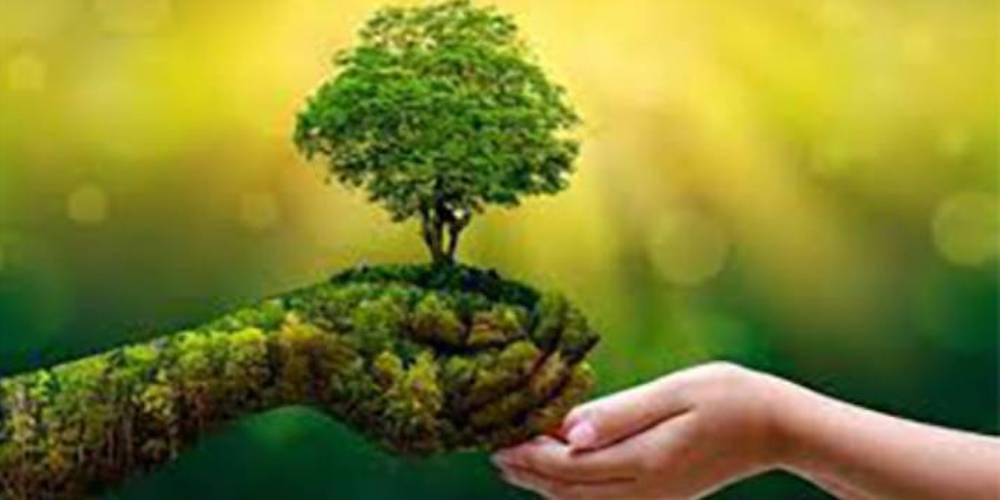
Over the last 11 years, under the leadership of Prime Minister Narendra Modi, this ancient wisdom has been turned into strong and practical action. India has moved from being a follower in global climate efforts to becoming a leader. Through clear policies, public participation, and a strong push for clean energy and sustainability, the government is working to build a greener, healthier and more secure future for everyone.
India has now emerged as a Climate Champion On The World Stage.
• At COP21 (Conference of Parties 21) in Paris, India pledged to achieve 40% of its installed electricity capacity from non-fossil fuel sources by 2030; a goal met ahead of time in November 2021.
• At COP26 in Glasgow, PM Modi launched LiFE (Lifestyle for Environment), encouraging sustainable habits and promoting mindful consumption over wasteful use. India also introduced the Panchamrit, five key targets for climate action.
• At COP29 in Baku (Nov 2024), India showcased its progress in climate adaptation and clean energy through global partnerships. Sessions focused on disaster-resilient infrastructure, industrial decarbonization, solar energy, and women-led climate action, in collaboration with Sweden, CDRI (Coalition for Disaster Resilient Infrastructure), ISA (International Solar Alliance) and NRDC (Natural Resources Defense Council).
Renewable Energy: From Promises To Performance
India made significant strides in renewable energy during FY 2024–25, achieving its highest-ever annual capacity addition. This progress reflects the country’s strong commitment to a cleaner, greener future.
India’s Clean Energy Progress
In FY 2024–25, India added a record 29.52 GW of renewable energy capacity, increasing the total installed capacity to 220.10 GW, up from 198.75 GW in FY 2023–24. This marks strong progress toward the 500 GW non-fossil fuel target by 2030.
Solar Energy
India’s solar energy installed capacity saw a 25.46-fold increase, rising from 2.82 GW in 2014 to 71.78 GW in April 2025. Solar tariffs dropped by 65%, from ₹6.17/kWh in 2014–15 to ₹2.15/kWh in 2024–25, making them the lowest in the world.
Wind Energy
Wind energy capacity grew 2.38 times, from 21.04 GW in March 2014 to 50.04 GW in March 2025. The government has set a target of achieving 140 GW of wind power capacity by 2030.
Nuclear Energy
Nuclear energy capacity has seen an 84% increase since 2014, rising from 4.78 GW to 8.78 GW in 2025.The government has set an ambitious target of 100 GW nuclear power capacity by 2047.
Global Recognition
India ranks 7th in the Renewable Energy Country Attractiveness Index. This reflects its growing global leadership in clean energy.
Flagship Initiatives for a Sustainable Future
India is paving the path toward a sustainable future through bold clean energy initiatives focused on solar power and green hydrogen. These efforts aim to reduce carbon emissions, enhance energy access, and foster rural and economic empowerment.
International Solar Alliance (ISA)
Launched by India and France at COP21 in 2015, ISA is a global platform promoting solar energy for energy access and climate action. Headquartered in India, it has 105 member countries and aims to mobilize $1 trillion in solar investments by 2030.
National Green Hydrogen Mission
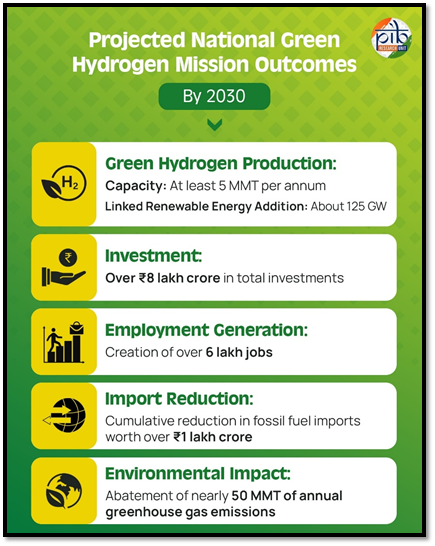
PM Surya Ghar: Muft Bijli Yojana (PMSGMBY)
Launched by Prime Minister Narendra Modi on February 15, 2024, PMSGMBY is the world’s largest domestic rooftop solar initiative. Focused on benefiting low-income households, the scheme has already brought rooftop solar to 11.88 lakh homes till April 2025. A dedicated digital platform ensures easy access to subsidies and loans, making clean energy adoption more accessible and efficient.
Model Solar Village | A Key Component of PM Surya Ghar Muft Bijli Yojana
Under this major component, one solar-powered model village will be developed in every district to promote decentralized solar adoption and rural energy self-reliance. With a total outlay of ₹800 crore, each selected village receives ₹1 crore in Central Financial Assistance. Eligible villages must be revenue villages with populations over 5,000 (or 2,000 in special category states). The initiative aims to create replicable models of solar-powered rural development across India.
PM-KUSUM (Pradhan Mantri Kisan Urja Suraksha evam Utthaan Mahabhiyan) Scheme
Launched in March 2019, the PM-KUSUM scheme promotes solar energy in agriculture by supporting solar-powered irrigation systems. It offers 30% to 50% central subsidy for new solar pumps and solarizing existing ones. The scheme targets solarisation of 49 lakh agricultural pumps in coming years, ensuring reliable energy for farmers and reducing carbon emissions.
UJALA Scheme (Unnat Jyoti by Affordable LEDs for All)
Launched on 5th January 2015 by Prime Minister Narendra Modi, UJALA (Unnat Jyoti by Affordable LEDs for All) promotes energy efficiency by distributing LED bulbs, tube lights, and fans. Initially called DELP (Domestic Efficient Lighting Programme), the scheme has helped reduce electricity consumption and made sustainable lighting affordable for millions. As of 6th January 2025, the UJALA scheme has distributed 36.87 crore LED bulbs.
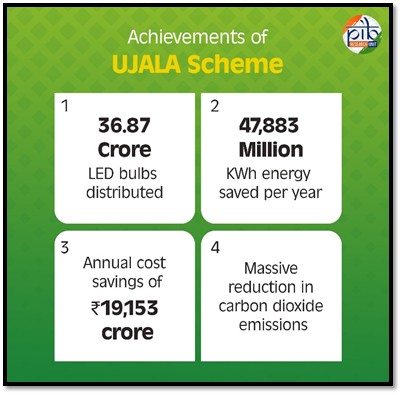
Conservation And Wildlife Protection: Nature Strikes Back
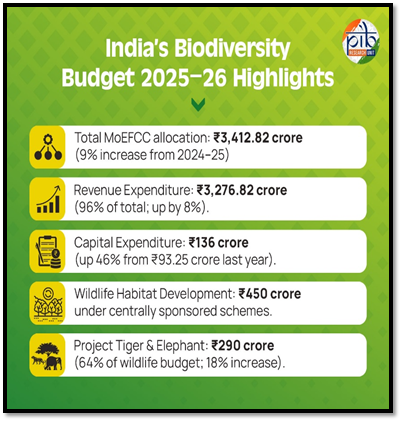
• Biodiversity Richness: Though covering just 2.4% of Earth’s land, India hosts 7–8% of global species, including 45,000+ plants and 91,000+ animals.
• Biodiversity Hotspots: India includes 4 major global hotspots; the Himalayas, Western Ghats, Northeast, and Nicobar Islands.
Forest cover has increased significantly
India State of Forest Report (ISFR) 2023 released in December 2024, the report shows India’s forest cover grew from 698,712 km² in 2013 to 715,343 km² in 2023. The country’s carbon sink reached 30.43 billion tonnes of CO2 equivalent, adding 2.29 billion tonnes since 2005. This progress aligns with India’s NDC (Nationally Determined Contribution) target of 2.5 to 3.0 billion tonnes by 2030, reflecting strong strides in forest conservation and reduced fire incidents.
Indian beaches have received Blue Flag Certification
The Foundation for Environment Education (FEE) in Denmark gives the Blue Flag certification, a global eco-label. The Blue Flag initiative began in France in 1985 as a symbol of excellence in environmental management, safety and sustainable tourism. In 1987, the first Blue Flag certifications were awarded across ten European countries, marking the beginning of it as a formal ecolabel. India joined the Blue Flag programme in 2018.
Palli in J&K became India’s first carbon-neutral panchayat.
Under the revamped National Panchayat Awards in 2023, Ministry of Panchayati Raj has instituted ‘Carbon Neutral Vishesh Panchayat Puraskar’ to award Panchayats for exemplary work towards achieving Net-Zero carbon emission.
The “Ek Ped Maa Ke Naam” campaign has seen the planting of over 142 crore trees.
On the occasion of World Environment Day, Prime Minister Narendra Modi launched the ‘Ek Ped Maa Ke Naam’ campaign, a unique initiative combining environmental responsibility with a heartfelt tribute to mothers. This campaign was inaugurated on June 5, 2024, with the planting of a Peepal tree by the Prime Minister at Buddha Jayanti Park in Delhi.
The Namami Gange Mission: A Holy Transformation
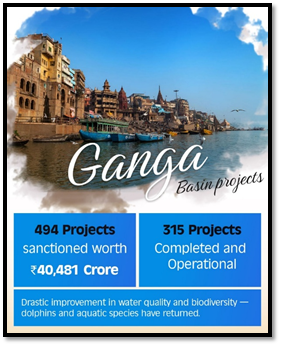
Swachh Bharat Mission (Urban)
The Swachh Bharat Mission-Urban (SBM-U) was launched on October 2, 2014, to address urban garbage, waste, and sewage issues. SBM-U 2.0 started on October 1, 2021, aiming for safe sanitation and scientific municipal solid waste management by 2026.
The budget outlay for Swachh Bharat Mission-Urban (SBM-U) from 2014 to 2021 was ₹62,009 crores, with a central share of ₹14,623 crores. For SBM-U 2.0 (2021-2026), the budget is ₹1,41,600 crores, including a central share of ₹36,465 crores.
SBM (Gramin) was launched on October 2, 2014, to achieve Open Defecation Free (ODF) status in rural India. By 2019, sanitation coverage rose from 39% to 100%, with 12 crore toilets built, improving health and hygiene. Phase II, started in 2020, focuses on ODF sustainability and waste management, aiming for ODF Plus by 2025-26.
Under SBM (Grameen), funds released over the past 10 years and the current year include ₹2,849.95 crore in 2014-15 and ₹3,014.06 crore in 2024-25.
Heritage, Tourism & Sustainability
Infra development with ecological conservation is the new hallmark of governance. Projects like the Kedarnath and Hemkund Sahib ropeways reflect this balanced vision of progress and preservation.
Kedarnath Ropeway Project: The Union Cabinet has approved the construction of ropeway project from Sonprayag to Kedarnath in Uttarakhand. The project is being developed on Design, Build, Finance, Operate and Transfer (DBFOT) mode. The ropeway project will be a boon to the pilgrims visiting Kedarnath as it would provide an environment-friendly, comfortable and fast connectivity and reduce travel time in one direction from about 8 to 9 hours to about 36 minutes.
Hemkund Sahib Ropeway: The Union Cabinet has approved two key ropeway projects in Uttarakhand under the National Ropeways Development Programme – Parvatmala Pariyojana. One of these connects to Hemkund Sahib Ji, located at an altitude of 15,000 feet and visited by 1.5–2 lakh pilgrims annually. Situated near the Valley of Flowers, a UNESCO World Heritage Site, the project will ensure smoother access while preserving the fragile Himalayan ecosystem through eco-friendly transport.
To conclude, as India’s ongoing journey proves that sustainable development is not a distant dream but a vibrant, achievable reality. From the deep cleaning of the Ganga to becoming a global renewable energy giant, and from reviving cheetahs to energizing villages with solar power, India is scripting a new ecological narrative one that blends heritage with innovation, local action with global leadership and vision with relentless execution. India’s green transformation is not just a policy shift. It is a people’s movement, a planetary commitment, and a promise to future generations.


